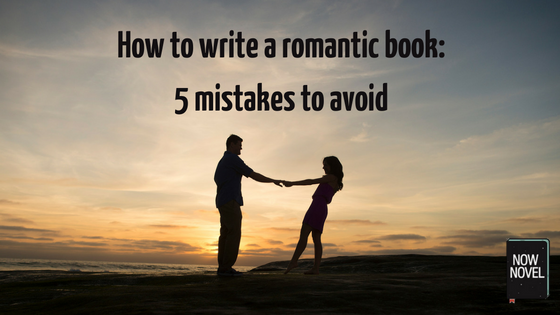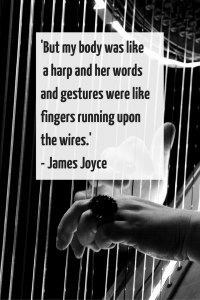Learning how to write a romantic book also means learning to avoid common romance writing mistakes. The best romance writers excel at finding romantic story ideas and fleshing them out with memorable character relationships. Here are 5 romance writing mistakes to avoid:
1: Avoid immediate, total attraction between your story’s lovers
The process of characters falling in love is half the adventure and excitement of many great romance novels. You might ask ‘What about Romeo and Juliet?’
It’s true that in Shakespeare’s classic play the lovers become infatuated at first sight. Yet building up to characters becoming lovers creates a core ingredient of great stories: narrative tension.
In Romeo and Juliet (1595), a prime example of a love story, the central tension is between the fated lovers’ warring families. Because the feuding Montagues and Capulets supply tension, the central story relationship does not need to supply as much. The nature of a play itself, too, as a shorter medium, means that events must happen faster.
Making your characters fly into each other’s arms at the start of your novel misses an opportunity for creating tension and romantic suspense. Making your romance peak too soon also leaves a lot of space for the rest of the story to fill. This could lead your plot to meander.
2: Be cautious of romance clichés: Eyes and hearts
Romance is often associated with cliché. This is partly because of the way love is commercialized. Each Valentine’s Day, masses of clichéd heart-shaped toys appear in stores, and these objects give a simplified idea of what love is and means.
The danger of using clichéd objects and symbols to describe your characters’ love is that they could read as vague or generic and hollow. Compare two romantic descriptions:
‘She loved him with all her heart. Every time she looked into his gentle blue eyes she felt deliriously happy.’
This clichéd description doesn’t tell us much about this particular love. The phrase ‘with all of her heart’ implies a love that is absolute, yet it is still an abstract image.
Similarly, the eye description doesn’t truly convey what is unique or interesting about the character’s passion for her beau. Compare the above to this description of absolute love from the brilliant romantic novel, Love in the Time of Cholera (1985) by Gabriel García Márquez:
‘His examination revealed that he had no fever, no pain anywhere, and that his only concrete feeling was an urgent desire to die. All that was needed was shrewd questioning … to conclude once again that the symptoms of love were the same as those of cholera.’
Márquez’s description of an absolute love has the benefit of fresh originality. Firstly, by comparing the feelings of his main character to cholera symptoms, Márquez suggests the extremity of his love. Secondly, the comparison to a deadly disease conveys the inherent personal risks of loving someone. Thirdly, Márquez’s comparison links the description to one of the central plot events of the novel (a cholera outbreak).
Instead of talking about characters’ eyes and hearts whenever you want to show strong feelings, brainstorm other similes and metaphors. Think of ways you can use broader imagery or themes from your novel in your lovers’ relationship. For example, if your main characters were musicians, this description from James Joyce’s Araby would be apt:
‘But my body was like a harp and her words and gestures were like fingers running upon the wires.’
3: Make sure there is sometimes trouble in paradise in your romantic writing
Some fantasy of perfection is perhaps expected during the ‘honeymoon phase’ of relationships, when your characters first discover their mutual attraction. Yet if your whole novel portrays your romantic leads as being ‘perfect’ for each other, this can have multiple negative effects:
- The relationship can feel dull and uninteresting because there is no rise and fall in action
- It may be harder for readers to relate to your characters and become invested. It’s easier to root for characters who have flaws or vulnerabilities like ourselves
Instead, think of obstacles that can come between your romantic duo, either in the build-up or once they are together. These create added dramatic tension and make the progression of the relationship believable. In the French movie Amelie (2001), the obstacle between the two leads is their mutual introversion and shyness. The viewer is kept waiting to see if one will summon the courage to approach the other.
One strategy for how to write a romantic book that isn’t completely idyllic is to bring in social and cultural circumstances or conflicts that keep your story’s lovers apart. Historical romance writers, for example, can pit lovers against historical events such as wars and other upheavals.
Good romance stories usually don’t only focus on the budding romance between the primary characters exclusively:
4: Be careful of making romance unfold in an isolated bubble
There are many examples of romantic novels that expertly bring in secondary plots and characters.
In Jane Austen’s Pride and Prejudice (1813), for example, the primary relationship is clearly between Elizabeth Bennett and Mr Darcy. Yet the inclusion of family ties and actions creates extra intrigue. Elizabeth’s youngest sister Lydia Bennett, for example, elopes with George Wickham, to the embarrassment of her family. This enriches the story while also making it less predictably focused on Elizabeth and Darcy’s eventual pairing.
If you want to write for Harlequin or another genre romance publisher, you might be required to focus more exclusively on a primary romantic relationship. Yet if you are writing a romantic (rather than formula-based) romance novel, expand your cast of characters. This will create opportunities to compare and contrast primary character relationships to secondary examples within your story.
5: Avoid over-the-top, groan-inducing sex scenes
Sex scenes are notoriously difficult to write. Translating a highly physical, personal act into descriptive language is challenging. So challenging, in fact, that Literary Review created the annual ‘bad sex’ writing award to ‘honour’ guilty authors. The awarded writing is often over-the-top, trying too hard to find sexy similes and metaphors.
If sex is a crucial component of your plot, then there’s every reason to hone your skill at writing sex scenes. Sex is a pivotal element of the 50 Shades of Grey series, for example . At the same time, critics lampooned the series for the content of its writing in general and sex scenes in particular. If you want to write better erotic scenes, this post by Gene Doucette offers some excellent advice.
When in doubt, skip sex scenes. Show the build-up and cut to afterwards. Often the most alluring or interesting scenes are when the reader may fill in the blanks and exercise imagination. An exception, as pointed out by Now Novel reader Donna in her comment on a previous post on romance writing, is when you use bad sex deliberately as a plot point.
What books do you think should be on every writer’s romance reading list? Join Now Novel’s romance writing group and start getting feedback on your own romantic fiction.




2 replies on “How to write a romantic book: 5 mistakes to avoid”
Your reference to the movie 50 Shades of Gray reminded me that, this story had no special characteristics except, a guy who wanted to have sex using toys. This is not such an unusual thing to give an Oscar to. Also, the actors were not acting any good. The girl moans before even the guy touches her. To use a sex-oriented movie you could have referred to the movie called 360. There, the story was different and the actors were very brave to act as the script required. I think the reason 50 Shades of Gray got this much publicity was that it was written by a woman and sex was a hidden desire of women at the time, and men wanted to bring it to open their own yearnings and this one brought it to open.
Dear Dophiea, Thanks so much for your reply. I’ll have a look at the film 360, and see if this can be incorporated into the post.